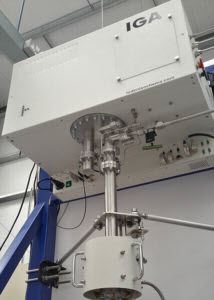
In an exciting new advance, a team of scientists from Hiden Isochema Ltd (Warrington, UK) and Cleveland State University (Ohio, USA) have developed a new way of analyzing materials for separating gases.
 Although gas separation using porous materials is an established technology, analytical techniques for assessing the performance of materials tend to be slow and laborious. The new Integral Mass Balance (IMB) method is faster and more accurate than existing techniques, and promises to accelerate new materials development for gas separation technology.
Although gas separation using porous materials is an established technology, analytical techniques for assessing the performance of materials tend to be slow and laborious. The new Integral Mass Balance (IMB) method is faster and more accurate than existing techniques, and promises to accelerate new materials development for gas separation technology.
Industrial gases affect many aspects of daily life. They are used to carbonate fizzy drinks, preserve food, and even to inflate balloons. Purified natural gas, meanwhile, is used across the globe as an energy source, for household cooking and heating.
Pure gases can be produced using porous materials that either extract the desired gas from a mixture or remove unwanted contaminants. For this purpose, understanding how materials interact with different gas mixtures is a crucial, but surprisingly difficult, task.
“Scientists and engineers have been working on these types of measurements for decades, but most current techniques are very time-consuming,” says Dr Darren Broom, Product Manager for Hiden Isochema. “A simple set of data can take weeks to measure. By combining two different methods, in a unique way, we have been able to speed up the process significantly.”
As a result, more materials can be analyzed, and a detailed understanding of how each material behaves under different conditions can be achieved. This is significant because chemists developing new porous materials for gas separations need to know how well a material performs. Often, they rely on models, which can be inaccurate, but the IMB method can rapidly and precisely assess new materials, helping to identify the best candidates for a given gas separation.
Industrial developers of gas separation processes, meanwhile, typically rely on relatively limited amounts of gas mixture data. Gas separation technology, such as Pressure Swing Adsorption (PSA), has been very successful and is used around the world to separate and purify gases. But the new technique will allow far more data to be collected in a practical timeframe, allowing chemical engineers to further optimize processes and improve efficiency.
Professor Orhan Talu, of the Department of Chemical and Biomedical Engineering at Cleveland State University, explains, “I have been making these kinds of measurements since the 1980s and they are very laborious, often taking weeks. With the IMB method, we have been able to make the same measurements in a matter of hours. The improvement in performance is impressive.”
To demonstrate the technique, the team have made measurements on a zeolite. Zeolites are porous materials with a range of uses, perhaps most notably in washing powder, but they are also particularly good at separating and drying gases. The reported measurements relate to oxygen (O2) production from air, by separating O2 from N2.
In medicine, where purified O2 is widely used, this technology is vital. Whilst small-scale and portable medical O2 generators are widely available for personal use, larger PSA O2 generators, filled with zeolites, have been installed at emergency field hospitals constructed to cope with the current coronavirus crisis, where reliable O2 supplies have been critical for treating patients.
“We chose these measurements because Professor Talu published similar data, measured on the same sample in two different laboratories, around 25 years ago,” said Broom. “However, we also wanted to do something of practical interest. As zeolites are currently used in commercially available medical O2 generators, this seemed an ideal choice.”
Now the team want to explore the technique’s range of applicability. “Having shown that the IMB method works for air separation using zeolites, we’d like to apply it to other important separations,” said Broom. “Capturing CO2 from power plant flue gases, for example, is of great interest, as this will help tackle the difficult and serious problem of climate change due to increasing greenhouse gas emissions.”
“The IMB method can provide reams of accurate data quickly,” added Professor Talu. “This will help accelerate the development of new materials and processes for such applications.”
Other future targets include separations used for natural gas upgrading and biogas purification, as well as hydrogen (H2) production and purification. Both H2 and natural gas are important for the transition to a low carbon energy future, in which fossil fuel use will be gradually phased out.
Further reading:
Integral Mass Balance (IMB) Method for Measuring Multicomponent Gas Adsorption Equilibria in Nanoporous Materials, Darren P. Broom, Orhan Talu, and Michael J. Benham
Ind. Eng. Chem. Res. 2020, 59(46), 20478–20491 DOI: 10.1021/acs.iecr.0c04162
About Cleveland State University
Founded in 1964, Cleveland State University is a public, urban research university that provides a dynamic setting for Engaged Learning. With an enrolment of more than 17,000 students, nine colleges and more than 200 academic programs, CSU is listed among America’s Best Colleges by U.S. News & World Report.
Read the most up to date Fuel Cell and Hydrogen Industry news at FuelCellsWorks




